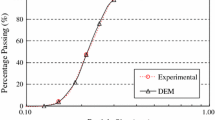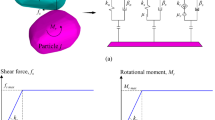Abstract
The at-rest coefficient of lateral pressure, \(K_0\), is a critical macroscopic parameter for evaluating stress transmission in granular media for engineering practice. This paper revisits the microscopic origin of \(K_0\) and its corresponding underlying physics based on micromechanics-based theories and numerical simulations, with a focus placed on the effect of particle shape. Two typical kinds of distortion (elongation and blockiness) in particle shape are considered, modeled by ellipsoids and superballs in the discrete element method. One-dimensional compression tests are performed on numerical specimens with dense and loose initial states for different particle shapes. An analytical relationship between \(K_0\) and anisotropy of fabric measures (i.e., contact normal, contact force, and shape-related anisotropy) is established within the stress-force-fabric framework. It is found that the analytical \(K_0\) is consistent with the measured one directly from the simulation regardless of particle shape, verifying a well-established relationship between \(K_0\) and fabric. It is further found that contact force partition of \(K_0\) plays the most prominent role in \(K_0\) compared to contact normal and shape-related partitions. Results also reveal the different influence of shape distortion on \(K_0\) and the corresponding mechanical properties related to \(K_0\), such as void ratio, mobilized friction angle, and coordination number. More specifically, \(K_0\) has a ‘W’-shape relationship with elongation for dense ellipsoids and an ‘M’-shape relationship with blockiness for superballs.















Similar content being viewed by others
References
Barr AH (1981) Superquadrics and angle-preserving transformations. IEEE Comput Graphics Appl 1(1):11–23
Christoffersen J, Mehrabadi MM, Nemat-Nasser S (1981) A micromechanical description of granular material behavior. J Appl Mech 48(2):339–344
Chu J, Gan C (2004) Effect of void ratio on k 0 of loose sand. Géotechnique 54(4):285–288
Cleary PW, Hilton JE, Sinnott MD (2017) Modelling of industrial particle and multiphase flows. Powder Technol 314:232–252
de Bono JP, McDowell GR (2016) Investigating the effects of particle shape on normal compression and overconsolidation using DEM. Granul Matter 18(3):1–10
Gao Y, Wang Y (2014) Experimental and dem examinations of \(k_0\) in sand under different loading conditions. J Geotech Geoenviron Eng 140(5):04014012
Gu X, Hu J, Huang M (2015) \(k_0\) of granular soils: a particulate approach. Granul Matter 17(6):703–715
Gu X, Hu J, Huang M, Yang J (2018) Discrete element analysis of the \(k_0\) of granular soil and its relation to small strain shear stiffness. Int J Geomech 18(3):06018003
Guo P (2010) Effect of density and compressibility on \(k_0\) of cohesionless soils. Acta Geotech 5(4):225–238
Guo P, Stolle D (2006) Fabric and particle shape influence on \(k_0\) of granular materials. Soils Found 46(5):639–652
Guo N, Zhao J (2013) The signature of shear-induced anisotropy in granular media. Comput Geotech 47:1–15
Jaky J (1944) The coefficient of earth pressure at rest. J Soc Hung Archit Eng 25:355–358
Kanatani K-I (1984) Stereological determination of structural anisotropy. Int J Eng Sci 22(5):531–546
Lee J, Yun TS, Lee D, Lee J (2013) Assessment of \(k_0\) correlation to strength for granular materials. Soils Found 53(4):584–595
Li X, Yu H (2011) Tensorial characterisation of directional data in micromechanics. Int J Solids Struct 48(14–15):2167–2176
Lirer S, Flora A, Nicotera M (2011) Some remarks on the coefficient of earth pressure at rest in compacted sandy gravel. Acta Geotech 6(1):1–12
Lopera Perez J, Kwok C, O’Sullivan C, Huang X, Hanley K (2015) Numerical study of one-dimensional compression in granular materials. Géotech Lett 5(3):96–103
Northcutt S, Wijewickreme D (2013) Effect of particle fabric on the coefficient of lateral earth pressure observed during one-dimensional compression of sand. Can Geotech J 50(5):457–466
Ouadfel H, Rothenburg L (2001) Stress-force-fabric relationship for assemblies of ellipsoids. Mech Mater 33(4):201–221
Perez JL, Kwok C, Huang X, Hanley K et al (2016) Assessing the quasi-static conditions for shearing in granular media within the critical state soil mechanics framework. Soils Found 56(1):152–159
Radjai F, Wolf DE, Jean M, Moreau J-J (1998) Bimodal character of stress transmission in granular packings. Phys Rev Lett 80(1):61
Sadrekarimi A, Olson SM (2011) Critical state friction angle of sands. Géotechnique 61(9):771–783
Santana T, Candeias M (2018) Effect of void ratio on \(k_0\) of a sand by means of triaxial stress-path testing. Geotech Geol Eng 36(1):257–266
Sarma S, Tan D (2006) Determination of critical slip surface in slope analysis. Géotechnique 56(8):539–550
Tian Q-H, Xu Z-W, Zhou G-Q, Zhao X-D, Kun H (2009) Coefficients of earth pressure at rest in thick and deep soils. Min Sci Technol 19(2):252–255
Wanatowski D, Chu J, Gan C (2009) Compressibility of Changi sand in \(k_0\) consolidation. Geomech Eng 1(3):241–257
Wang Y-H, Gao Y (2014) Examining the behavior and mechanisms of structuration in sand under the \(k_0\) condition. Granul Matter 16(1):55–68
Weng M-C, Cheng C-C, Chiou J-S (2014) Exploring the evolution of lateral earth pressure using the distinct element method. J Mech 30(1):77–86
Williams JR, Pentland AP (1992) Superquadrics and modal dynamics for discrete elements in interactive design. Eng Comput 9(2):115–127
Yan W, Dong J (2011) Effect of particle grading on the response of an idealized granular assemblage. Int J Geomech 11(4):276–285
Yang J, Dai B (2011) Is the quasi-steady state a real behaviour? A micromechanical perspective. Géotechnique 61(2):175–183
Yun TS, Lee J, Lee J, Choo J (2015) Numerical investigation of the at-rest earth pressure coefficient of granular materials. Granul Matter 17(4):413–418
Zhang T, Zhang C, Yang Q, Fu R (2020) Inter-particle friction and particle sphericity effects on isotropic compression behavior in real-shaped sand assemblies. Comput Geotech 126:103741
Zhao S, Zhao J (2019) A poly-superellipsoid-based approach on particle morphology for dem modeling of granular media. Int J Numer Anal Meth Geomech 43(13):2147–2169
Zhao S, Zhao J (2021) SudoDEM: unleashing the predictive power of discrete element method on simulation of non-spherical granular particles. Comput Phys Commun 259:107670
Zhao S, Zhou X (2017) Effects of particle asphericity on the macro-and micro-mechanical behaviors of granular assemblies. Granul Matter 19(2):38
Zhao S, Zhang N, Zhou X, Zhang L (2017) Particle shape effects on fabric of granular random packing. Powder Technol 310:175–186
Zhao S, Evans TM, Zhou X (2018) Shear-induced anisotropy of granular materials with rolling resistance and particle shape effects. Int J Solids Struct 150:268–281
Zhao S, Evans T, Zhou X (2018) Effects of curvature-related dem contact model on the macro-and micro-mechanical behaviours of granular soils. Géotechnique 68(12):1085–1098
Zhao Y, Yang H, Huang L, Chen R, Chen X, Liu S (2019) Mechanical behavior of intact completely decomposed granite soils along multi-stage loading-unloading path. Eng Geol 260:105242
Zhao Y, Yang H, Chen Z, Chen X, Huang L, Liu S (2019) Effects of jointed rock mass and mixed ground conditions on the cutting efficiency and cutter wear of tunnel boring machine. Rock Mech Rock Eng 52(5):1303–1313
Zhu J-G, Jiang M-J, Lu Y-Y, Guo W-L, Zhang B (2018) Experimental study on the \(k_0\) coefficient of sandy gravel under different loading conditions. Granul Matter 20(3):40
Acknowledgements
This work was financially supported by the National Natural Science Foundation of China (by Project No. 51909095, No. 51679207 and No. 11972030), Guangdong Basic and Applied Basic Research Foundation (2020A1515011525), and the Fundamental Research Funds for Central Universities (D2192710). Any opinions, findings, and conclusions or recommendations expressed in this material are those of the authors and do not necessarily reflect the views of the financial bodies.
Author information
Authors and Affiliations
Corresponding author
Additional information
Publisher's Note
Springer Nature remains neutral with regard to jurisdictional claims in published maps and institutional affiliations.
Appendices
Appendix A: Tensors of stress-force-fabric relationship
By analogy to formula of stress tensor [15, 19], integral form of Eq. (4) can be determined as:
where \(N_c\) is the total contact number, \(E({{\varvec{n}}})\) is the probability distribution function (PDF) of contact normal, \(\bar{f_{i}}({{\varvec{n}}})\) and \(\bar{d_{j}}({{\varvec{n}}})\) are directional distribution function of contact force vector and branch vector.
The second-order approximation of \(E({{\varvec{n}}})\) takes the expansion form [13]:
Second-order tensor \(G_{ij}^{u}\) is determined as:
where \({\varPhi _{ij}'}\) is the deviatoric part of \({\varPhi _{ij}}\) and can be found as \({\varPhi _{ij}} - \delta _{ij}{\varPhi _{kk}}/3\) (in which \(\delta _{ij}\) is the Kronecker delta).
The second-order approximation of \(\bar{f_{n}}({{\varvec{n}}})\) or \(\bar{d_{n}}({{\varvec{n}}})\) can be rewritten as:
And second-order approximation of \(\bar{f_{i}^{t}}({{\varvec{n}}})\) or \(\bar{d_{j}^{t}}({{\varvec{n}}})\) are:
Anisotropic fabric tensors of normal and tangential contact force (\(G_{ij}^{f_{n}}\) and \(G_{ij}^{f_{t}}\)) or branch vectors (\(G_{ij}^{d_{n}}\) and \(G_{ij}^{d_{t}}\)) are determined by:
Corresponding tensor \(K_{ij}^{*}\) (superscript * stands for \(f_n\) or \(d_n\)) are given by:
Substitutes Eq. (A.2), Eq. (A.5) and Eq. (A.6) into Eq. (A.1) leads to:
We decompose stress tensor as a sum of isotropic term and anisotropic term, Eq. (A.9) is rewritten as:
Isotropic and anisotropic terms are given:
Appendix B: Decomposition of stress tensor
Finally, partitions of stress tensor can be determined as:
where
Substitutes Eq. (A.11), Eq. (B.2) into Eq. (B.1) we link up the \(\sigma _{ij}\) and \(G_{ij}^{(*)}\) tensors (superscript * stands for u, \(f_{n}\), \(f_{t}\), \(d_{n}\) and \(d_{t}\)).
Isotropic and anisotropic terms are individual now, and stress tensors is derived by these two terms (third-order terms are neglected):
Rights and permissions
About this article
Cite this article
Chen, H., Zhao, S., Zhao, J. et al. The microscopic origin of K0 on granular soils: the role of particle shape. Acta Geotech. 16, 2089–2109 (2021). https://doi.org/10.1007/s11440-021-01161-5
Received:
Accepted:
Published:
Issue Date:
DOI: https://doi.org/10.1007/s11440-021-01161-5




